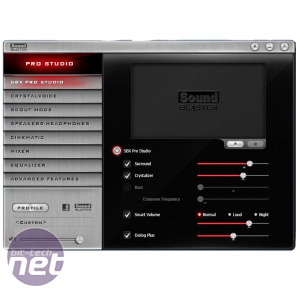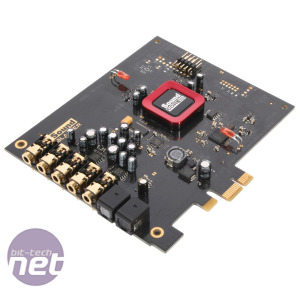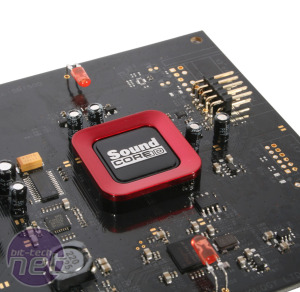
Creative Sound Blaster Z Review - Components
While the Z lacks some of the premium components used by its sister ZxR sound card, it still has reasonable selection of dedicated op-amp chips for various outputs. Following on from the SoundCore3D chip at the heart of the card, a 24-bit/192 kHz Cirrus Logic CS4398 digital-to-analogue converter (DAC) feeds the card's analogue stereo line and headphone outputs. A JRC 2114 op-amp is used for line output while a MAX97220A headphone amplifier powers the headphone output on the back panel, which is capable of handling studio-grade headphones with an impedance of 600 ohms. A second MAX97220A is used for the back panel centre/sub connector and the sound card's front panel connector for your case. Finally, a JRC4556a op-amp is used for surround sound rear-out in 7.1 configurations.The Analogue-to-Digital Converter (ADC) that handles the mic/line input is integrated into the SoundCore3D itself. The SoundCore3D combines its Quartet Digital Signal Processor (DSP) with a codec (combined DAC and ADC) on a single chip, quoting Signal-to-Noise Ratios (SNR) of 102dB for the DAC and 101dB for the ADC. The sound card's front output has an SNR 116dB and 24-bit/192KHz bitrate and sample rate.
The audio processor is the Z's most immediately obvious advantage over cards from other manufacturers. Most sound cards rely heavily on drivers to handle tasks such as audio effects processing, environmental sound within games and virtual surround sound through stereo headphones, which means that your CPU is going to be doing a great deal of the work there. The SoundCore3D handles almost everything internally, but most CPUs aren't exactly going to buckle under the load of a bit of audio processing so, although the audio processor's definitely a nice bit of kit, the simple fact of its existence isn't compelling reason to buy the card in and of itself. We can take a closer look at the features it provides by going through the many options built into Creative's driver.
The SBX Pro Studio options - previously branded as THX Tru Studio - lets you control surround sound levels and apply a Crystalizer that's designed to compensate for the dynamic range compression that's applied to a lot of modern studio recordings and bass enhancement. However, we found that we preferred listening to music with all of these settings disabled. The combinations of Crystalizer and Bass enhancement in particular made many tracks sound boomy and harsh, but they provide effective enhancement for games and movies.


Click to enlarge - The re-branded Pro Studio offers plenty of adjustment options, although not all are worthwhile.
CrystalVoice gives you a range of effects that apply to the mic input, including noise reduction and echo cancellation. These are particularly useful if you use the stand-alone mic that comes with the sound card rather than a headset mic, and effectively minimise the effect of background noise and ambient acoustics. Also useful for this is the Focus setting, which suppresses sounds originating from anywhere except a specified zone directly in front of the mic - you can adjust how wide this is. The advantage of the supplied mic - which is designed to perch neatly on top of your monitor - and the advanced ambient mic noise cancellation options is that you can use a pair of high-quality headphones for gaming without having your buying options restricted by the need for a dedicated headset.
The CrystalVoice settings also include a number of vocal effects that can shift your gender or make you sound like a demon from the abyss, which are an entertaining extra for dedicated role-players, if nothing else. Another gaming-oriented option is Scout Mode, which makes enemy movements more audible, allowing you to pinpoint threats easily. You can map the mode to a key combination of your choice, which makes it easy to enable and disable at will. This is definitely a benefit, as - while scout mode makes your enemies footsteps clearer - it also amplifies your own movement sounds, so you won't want to leave it on most of the time.

MSI MPG Velox 100R Chassis Review
October 14 2021 | 15:04










Want to comment? Please log in.